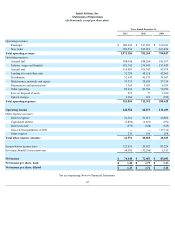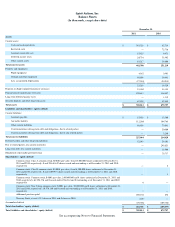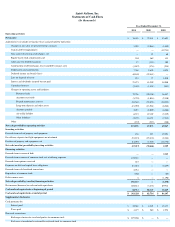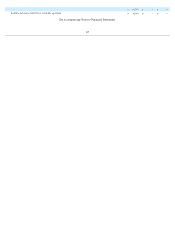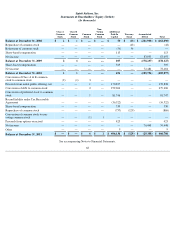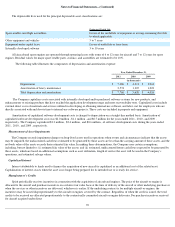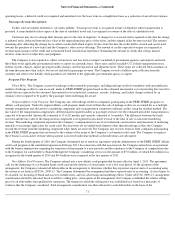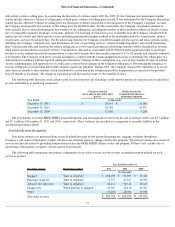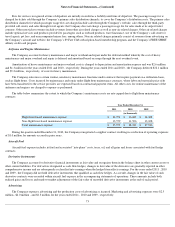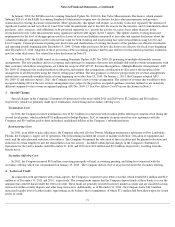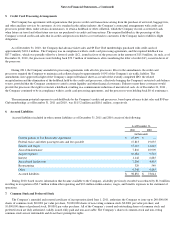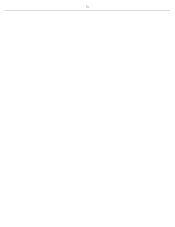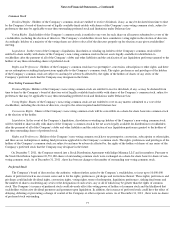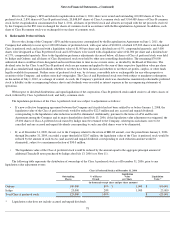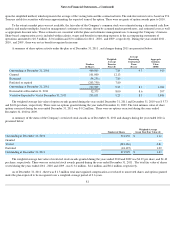Spirit Airlines 2011 Annual Report Download - page 83
Download and view the complete annual report
Please find page 83 of the 2011 Spirit Airlines annual report below. You can navigate through the pages in the report by either clicking on the pages listed below, or by using the keyword search tool below to find specific information within the annual report.
Notes to Financial Statements—(Continued)
Fees for services recognized at time of departure are initially recorded as a liability until time of departure. The passenger usage fee is
charged for tickets sold through the Company’s primary sales distribution channels, to cover the Company’
s distribution costs. The primary sales
distribution channels for which passenger usage fees are charged include sales through the Company’s website, sales through the third-party
provided call center, and sales through travel agents; the Company does not charge a passenger usage fee for sales made at its airport ticket
counters. Other non-ticket revenues include revenues from other air related charges as well as non-air related charges. Other air related charges
include optional services and products provided to passengers such as onboard products, travel insurance, use of the Company’s call center or
travel agents, pet fees, and unaccompanied minor fees, among others. Non-air related charges primarily consist of revenues from advertising on
the Company’s aircraft and website, the Company’s $9 Fare Club subscription-based membership program, and the Company’s FREE SPIRIT
affinity credit card program.
Airframe and Engine Maintenance
The Company accounts for heavy maintenance and major overhaul and repair under the deferral method whereby the cost of heavy
maintenance and major overhaul and repair is deferred and amortized based on usage through the next overhaul event.
Amortization of heavy maintenance and major overhaul costs is charged to depreciation and amortization expense and was $2.6 million
and $1.3 million for the years ended 2011 and 2010 , respectively. During the years ended 2011 and 2010 , the Company deferred $22.1 million
and $5.2 million , respectively, of costs for heavy maintenance.
The Company outsources certain routine, non-heavy maintenance functions under contracts that require payment on a utilization basis,
such as flight hours. Costs incurred for maintenance and repair under flight hour maintenance contracts, where labor and materials price risks
have been transferred to the service provider, are expensed based on contractual payment terms. All other costs for routine maintenance of the
airframes and engines are charged to expense as performed.
The table below summarizes the extent to which the Company’s maintenance costs are rate capped due to flight hour maintenance
contracts:
During the quarter ended December 31, 2010, the Company renegotiated a supplier contract resulting in a reduction of operating expenses
of $1.0 million for amounts accrued in prior years.
Aircraft Fuel
Aircraft fuel expense includes jet fuel and associated “into-plane” costs, taxes, oil, and all gains and losses associated with fuel hedge
contracts.
Derivative Instruments
The Company accounts for derivative financial instruments at fair value and recognizes them in the balance sheet in other current assets or
other current liabilities. For derivatives designated as cash flow hedges, changes in fair value of the derivative are generally reported in other
comprehensive income and are subsequently reclassified into earnings when the hedged item affects earnings. For the years ended 2011 , 2010
and 2009 , the Company did not hold derivative instruments that qualified as cash flow hedges. As a result, changes in the fair value of such
derivative contracts were recorded within aircraft fuel expense in the accompanying statements of operations. These amounts include both
realized gains and losses and mark-to-market adjustments of the fair value of unsettled derivative instruments at the end of each period.
Advertising
The Company expenses advertising and the production costs of advertising as incurred. Marketing and advertising expenses were $2.5
million , $4.0 million , and $2.3 million for the years ended 2011 , 2010 and 2009 , respectively.
73
Year Ended December 31,
2011
2010
2009
(in thousands)
Flight hour-based maintenance expense
$
21,974
$
16,683
$
14,428
Non-flight hour-based maintenance expense
13,579
11,506
13,108
Total maintenance expense
$
35,553
$
28,189
$
27,536


